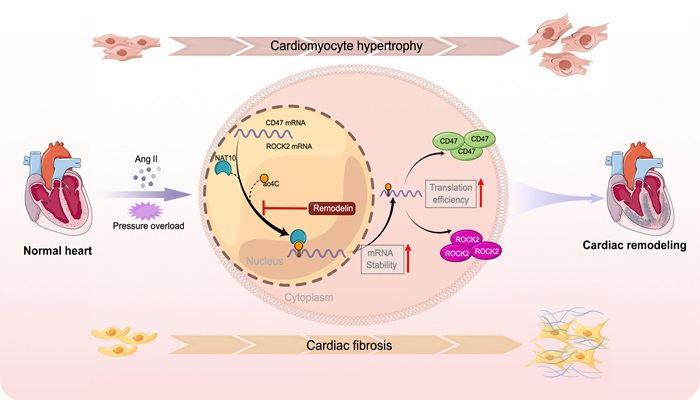Vascular remodeling is a critical pathological process following vascular injury and plays a significant role in cardiovascular diseases, including atherosclerosis, hypertension, restenosis, and myocardial infarction. Vascular smooth muscle cells (VSMCs) are the primary cell type in vascular tissue. Under pathological conditions, VSMCs can shift from a contractile state to a proliferative secretory state. This transformation leads to abnormal cell proliferation and migration, resulting in vascular intimal hyperplasia. Understanding the molecular mechanisms behind VSMC phenotypic changes may aid in developing new treatments for vascular remodeling.
RNA modification is an emerging area within epigenetics. N-acetyltransferase 10 (NAT10) modifies mRNA by adding N4-acetylcytidine (ac4C), which influences mRNA stability and protein translation efficiency. Previous studies have shown that inhibiting NAT10 expression or its acetylase activity can provide protective benefits in conditions like myocardial hypertrophy and cancer. However, its specific role in vascular remodeling has not been clearly defined.
On October 25, 2024, a research team led by Professor Chunyu Zeng, Associate Professor Junyi Yu from the Army Medical University’s Army Specialty Medical Center, and Professor Lianglong Chen from Fujian Medical University published findings in the European Heart Journal. The study, titled “NAT10 Promotes Vascular Remodeling via ac4C mRNA Acetylation,” details how NAT10 regulates VSMC phenotypic transformation and induces vascular remodeling through mRNA ac4C modification. This research presents new insights into RNA modification’s role in vascular remodeling and identifies mRNA ac4C modification as a potential target for treating related diseases.
To investigate NAT10’s role further, the researchers created smooth muscle cell-specific knockout mice (NAT10VSMC-/-) using the loxP-Cre system. They observed that NAT10 expression and ac4C modification levels were significantly reduced in the carotid artery tissue of these knockout mice. This change reversed the decrease in smooth muscle contractile markers, such as α-SMA, Calponin, and SM22, caused by guidewire injury. Additionally, local treatment with NAT10 knockdown adenovirus in a rat carotid artery balloon injury model significantly reduced intimal regeneration, whereas NAT10 overexpression exacerbated neointimal formation.
These animal studies demonstrate that NAT10 is essential for VSMC phenotypic transformation and vascular remodeling.
Overall, this research highlights the critical role of NAT10 in promoting VSMC changes and vascular remodeling through mRNA ac4C modification. It illustrates the molecular mechanisms involved, using Itgb1 and Col1a2 as examples. The findings suggest that targeting NAT10 may offer new therapeutic options for preventing and treating vascular remodeling-related diseases.
Related topics:


